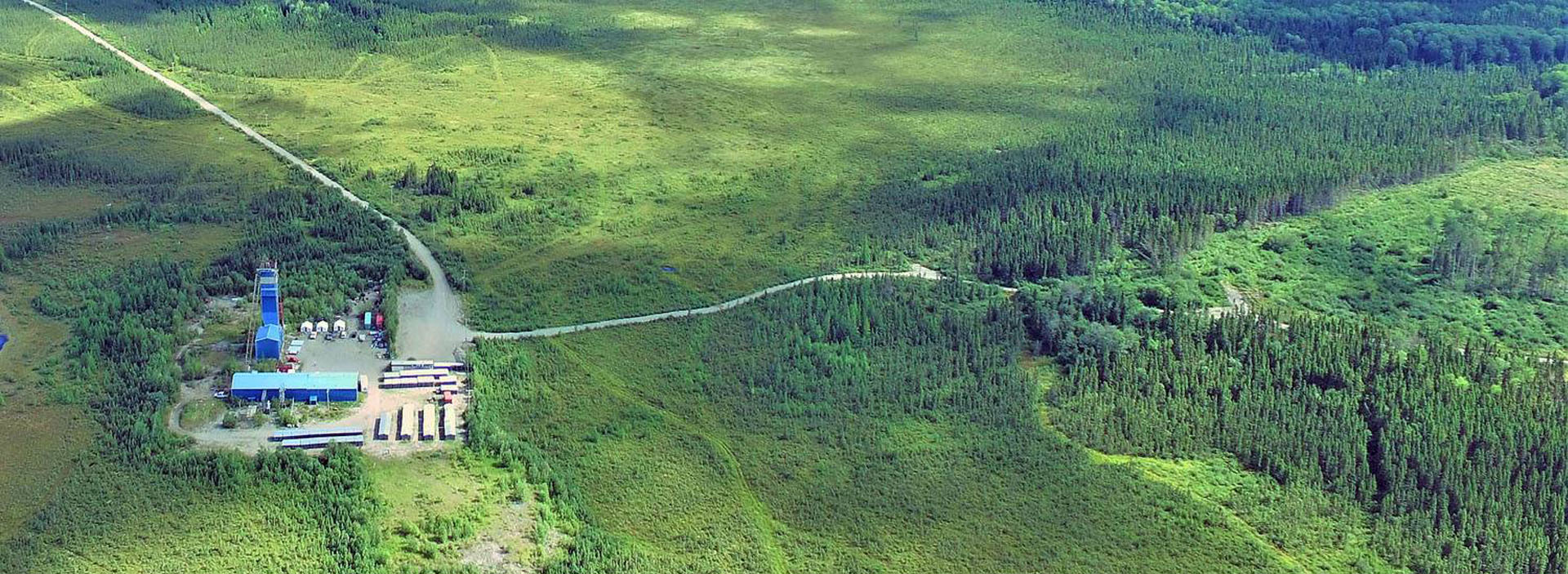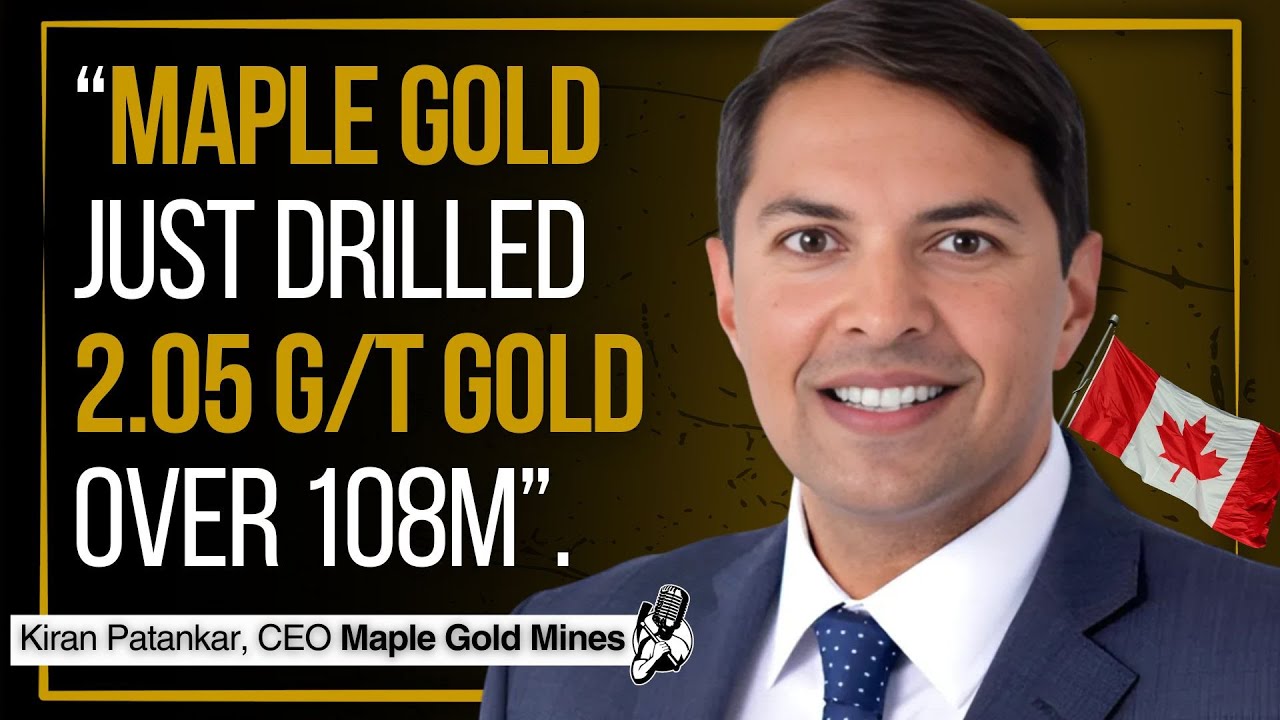2 g/t Over 108 Metres in Quebec | TSX-V: MGM
Maple Gold Mines is working on the Douay Gold Project in Quebec, which hosts over 3 million ounces of gold in a fragmented resource across multiple zones. This conversation with CEO Kiran Patankar focused on the company’s current 10,000-metre drill program, including a deeper intercept at the Nika Zone that may suggest underground potential. The discussion examined drill targeting, capital management, geological interpretation, and the challenges of advancing a large but dispersed system toward a viable development scenario.
TL;DR
- Maple Gold has completed 70% of its 10,000-metre drill program at Douay and remains both on schedule and under budget.
- Hole 338 at the Nika Zone returned 2.05 g/t over 108 metres at roughly 500 metres depth, prompting immediate follow-up drilling for potential underground continuity.
- The company is fully funded to complete the current program, with no immediate need to raise additional capital.
- A new resource update is planned to include underground domains, moving beyond the open-pit-only assumptions of the 2022 model.
- The Douay resource remains spread across multiple zones, and the company is evaluating whether these can support a coherent, staged mining scenario.
How is the drill program going?
Maple Gold Mines’ CEO, Kiran Patankar, describes the current drill program as “going fantastic,” highlighting that it is both on time and under budget. The company has drilled over 7,000 meters of the planned 10,000 meters at the Douay project, representing 70% completion. Patankar emphasizes the significance of the recent results: “Gold encountered in every hole, but in particular, the Nika zone step-out hole that we announced, hole DO-25-338, was a clear standout.” Two rigs are currently active, focusing on follow-up drilling at the Nika zone, with expectations to complete the program on schedule and within budget.
Is the drill program infill or step-out?
Patankar challenges the conventional infill versus step-out dichotomy, given Douay’s scale. While the market may see the majority of drilling as infill, he clarifies that many holes target open gaps within the resource footprint, some as large as 200 meters. “Some of the holes that we announced may look like infill holes, but when we designed the step-out it was a 300 meter down plunge step-out from the nearest drill hole.” He estimates a 70/30 split between drilling within the resource area and outside it, but stresses that most “infill” holes are designed to add new ounces and upgrade resource quality rather than simply confirm existing mineralization.
How much money do they have left?
Maple Gold Mines entered the year with $8 million in cash. The company’s all-in drilling costs are coming in under the originally budgeted $400 per meter. Patankar notes that efficiency gains mean “every incremental dollar that we save, is just more meters that we can drill.” With the main drilling season underway and two rigs operating, the company is utilizing frozen ground for accessibility and efficiency. The program’s flexibility allows for adaptive follow-up drilling in response to positive results, particularly at Nika.
Will they have to raise money soon?
Patankar is unequivocal: “Are we financed for the year? Absolutely.” The company raised enough capital in 2023 through a restructured deal with Agnico Eagle and a brokered placement to fund the current program and avoid near-term dilution. He states, “We are not out here to try to just dilute shareholders,” and emphasizes that the company is fully funded for its planned catalysts and news flow for the year.
When are the rest of the assays coming out?
Assay results will be released “as soon as practical after we have the final assays,” with the company prioritizing material results. Patankar expects “steady news flow over the next couple weeks going into the summer.” With a queue of assays pending at the labs and ongoing drilling, he anticipates regular updates as results are vetted and interpreted. The company will reassess its program after completing the current 10,000-meter phase, with a fully funded 3,000 meters planned at Joutel Gold to follow.
How are the ground conditions?
Ground conditions are described as excellent. “The core looks beautiful, the team at Major Drilling are doing a fantastic job.” There have been no significant issues with core loss or recovery. Patankar credits the team’s technical work and notes the advantage of working during the freeze, which facilitates drilling and access.
Is the new intercept too deep?
The headline intercept, 2.05 grams per tonne gold over 108 meters, was encountered at about 500 meters vertical depth, deeper than most of Douay’s current resource. Patankar argues that this depth is not a drawback, citing regional analogues where vertical continuity is key: “If you start looking at other deposits in the region, when they transition from open pit to now mining underground, the kinds of grades and thicknesses that they were encountering are not flashy.” He points to the potential for bulk underground mining, noting that “56 meters of 3 grams at these depths is pretty darn good from an underground mining standpoint.” The intercept is seen as a potential nucleus for a future mine scenario, especially when combined with existing infrastructure and other nearby zones.
How much more drilling before they understand the continuity?
Patankar believes that the holes already completed and those currently planned, specifically a wedge hole, a re-entered historical hole, and a new hole between previous intercepts, should provide “a very good sense of what it is.” He references the company’s technical report, which outlines the drill spacing required for inferred resources, and stresses that the goal is not to rush to a mine plan but to “demonstrate areas that, had not only the space to grow ounces but also the geological support.” The company will let data drive decisions, remaining open-minded about the ultimate mining scenario.
What would the cut-off grade for UG be here?
It is “a little bit early to be thinking about cutoff grades until we’ve actually done some of those trade-off studies.” Patankar notes that comparable underground operations in the region have reported similar grades at similar depths. He emphasizes the need for more detailed modeling and scenario analysis before establishing underground cut-offs, but indicates that the company is moving toward a more sophisticated “geo-mine-met” approach for future resource updates.
Do they understand the mineralogical context at Nika?
No metallurgical testing has been done on the new Nika intercept, but Patankar says it appears similar to other zones where early metallurgy indicated “very good recoveries, no arsenic.” The mineralization is associated with fine-grained pyrite (5-10% sulfide), consistent alteration, and a syenitic host rock. He notes, “The rock looks very consistent, it doesn’t jump out at you,” but the technical team is conducting detailed logging and oriented core work to refine structural and mineralogical interpretations.
How big does the deposit have to be for it to be mineable?
Patankar offers a rule of thumb: “If you had 100,000 ounces of production over a 10-year mine life, you had a million economic ounces. That’s a decent starting point.” He stresses that leveraging existing mill capacity in the region would maximize returns, while larger standalone projects would require more ounces. “If we started with 3 million ounces today and we ended up with a million of that in indicated and we start pushing forward a development scenario on that, I think we’d be pleased.” He cautions against rushing to a PEA on a small resource, preferring a methodical approach that balances de-risking with continued exploration.
Could Nika add anything to the 2005 PFS?
Patankar suggests that the Nika zone could indeed change the picture for future studies, stating, “With one hole we’ve kind of changed the game plan at that zone.” He sees potential for Nika and other new discoveries to materially impact future resource and economic studies, but does not commit to specifics at this stage.
Why spend money & time on Douay Quest?
Douay Quest is described as a calculated risk, based on geophysical and structural targets outside the main mineralized trend. Patankar explains, “If we’re going to tell people that we think the deposit has potential to grow, we have to actually go and take some of those shots.” Success at Douay Quest would look different from core resource areas, but even anomalous mineralization would be valuable for understanding the broader system. The company is intentionally allocating a portion of its budget to higher-risk, higher-reward targets to demonstrate the project’s regional potential.
Is it a problem that the deposit is not 1 orebody?
Patankar acknowledges this as a key challenge: “That’s been the biggest knock on Maple, you got all these zones, it doesn’t hold together as a single pit.” He argues that many successful mines started with multiple zones and smaller resources, with infrastructure enabling further growth. “If you can find something that has a nucleus of a starter operation and you have all these other zones, it becomes the gift that keeps on giving.” He points to regional analogues like Malartic and Windfall, which began with similar challenges and grew into major operations. The company’s strategy is to focus on areas that could form the basis for early mining scenarios, while continuing to explore the broader footprint for additional zones.
What did you come here hoping to talk about that I failed to bring up?
Patankar does not raise any major omissions, instead referencing the analogies used throughout the interview (layer cake geology, jigsaw puzzles) and expressing enthusiasm for future conversations. No substantive new topics are introduced in this closing exchange.
Maple Gold Mines Interview with CEO, Kiran Patankar
VERY IMPORTANT WARNING
Please note that Resource Talks has received monetary compensation from Maple Gold Mines for the production of this content. This website is not a research platform – it’s a business that aims to receive compensation for the creation and publication of content from the parties that it covers. This means there will always be a potential conflict of interest which means you can never rely on anything said herein.
By consuming this content, you acknowledge that Resource Talks and/or its affiliates and/or their personnel may own, have owned, or will own interests in and/or may have a business relationship with some or all companies/entities mentioned/featured in this publication. You further acknowledge that entities which may be referenced or featured in this publication or their related parties may hold an interest in Resource Talks or its affiliates, which may create further conflict of interest.
The information provided herein is general & impersonal in nature and meant for entertainment purposes only. The reader acknowledges and agrees that the information does not constitute a solicitation of an offer to buy or sell any security or instrument or to participate in any trading strategy. The author is not a licensed investment advisor. He is just another talking head on the internet. He might own shares of companies mentioned in this publication. Always assume he doesn’t know much more than a potato does. The mining & exploration space is among the riskiest sectors to invest in. The risk of anything mentioned in this publication is 100% loss of capital. If you don’t read the official documents provided by the company on http://www.SedarPlus.ca, you will lose all of your money.


